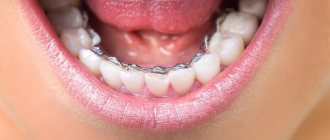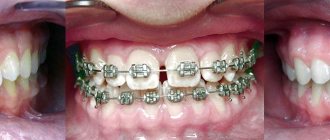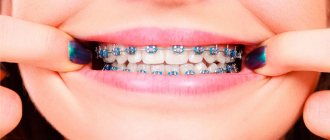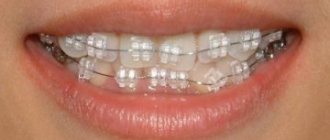Hi all! My name is Sakadynets Alexander, I have been practicing for 12 years and the number of my patients has exceeded 1000. Very often I hear repeated questions from my patients, and I understand how little quality information there is on the Internet and other sources. Sometimes the questions are logical, sometimes they are formed from incorrect information taken from various sources. Alas, myths and prejudices regarding braces still exist in society: supposedly braces contribute to the development of oral diseases, treatment with braces is painful, braces are created only for people under 18 years of age, etc. So, it’s time to collect all these questions in a bunch and try to give explanatory answers to them. I would like to note right away that not a single article can replace a live consultation with a doctor; it is for general informational purposes only.
I want braces on one jaw!
Quite a tempting option for many. But it should be understood that the answer lies already in the name “bracket-SYSTEM”, which implies the SYSTEMIC work of the orthodontic apparatus. And initially, such a decision may be completely wrong, and the amount saved will no longer be so, because all the treatment, and most importantly - time, will go down the drain.
Why?
It's all about the relationship between the upper and lower jaws: when one row of teeth moves, the other follows. And the conclusion from this is the following: braces are not installed with the aim of “straightening” some teeth. The braces system helps to change the position of the dentition in order to improve the bite! Simply put, a proper bite is when one jaw fits over the other like the gears in a watch.
What happens while wearing braces on one jaw? While the system has moved the tooth in the desired direction, another row of teeth tries to move it back. However, in some cases, the option of installing braces on one jaw is acceptable. For example, if the bite is already correct, but there is symmetry of the jaws. Or when connecting another jaw is necessary based on the patient’s clinical case.
Photo while wearing braces
Photo after wearing braces
Types of braces and wearing time
The duration of wearing braces to correct teeth is determined by various factors - the age of the patient, the degree of the problem, the presence of chronic dental diseases. This time also depends on the type and characteristics of the orthodontic structure.
Metal braces are placed on the outside of the teeth. The period during which the bite can be corrected with this system is about 1.5 years. Modern ceramic braces have an attractive appearance, and the treatment time is 1-3 years; They are hardly noticeable on the teeth. Sapphire braces systems and transparent orthodontic locks are also worn for 1 to 3 years.
The lingual brace system is fixed on the inside of the dentition; its advantage is that it is not visible to others. The average length of time to wear braces of this type is 1.5-2 years.
On average, over one month, teeth move 1 mm in a given direction. The effect will first be noticeable 3-4 months after installation of the system. There are dental anomalies when it is necessary to be treated for a long time. After removing the system, you will have to wear retainers to secure the position of the aligned dentition.
Will braces ruin my teeth?
Let me say right away that braces do not damage your teeth. But only subject to hygiene rules and doctor’s recommendations. But here it is better to dispel several myths at once:
No. 1 Teeth under braces will definitely deteriorate
Nothing exactly happens under the braces, but the whole problem usually occurs around the braces - if the patient does not brush his teeth after every meal, then caries forms as a result.
Or if the patient has a strong tendency to form plaque (in this case, hygiene should be more careful). But if the patient could not agree on hygiene during treatment, then I usually suggest, and sometimes insist, that the orthodontic treatment be completed.
No. 2: The enamel may come off along with the braces.
When removing the braces, the doctor leaves some of the glue on the tooth, which is then easily removed with a bur, and then the teeth are polished. In this case, the enamel remains intact and unharmed.
#3: Teeth may fall out after braces.
Basically, patients understand that after proper treatment this is in no way possible. Mobility of teeth during treatment with braces - this happens, and this is normal (after all, teeth move, and this is quite logical). Retention, consisting of both removable and non-removable devices (retainers, mouth guards, plates), will help maintain the position of teeth after treatment, which will help keep the teeth in their correct position.
What can increase treatment time?
When installing braces, the dentist determines only the approximate duration of treatment, which may differ significantly in the outcome. At the same time, this period does not decrease, but only increases.
This may be due to several reasons:
- Poor oral hygiene leading to periodontal disease.
In some cases, inflammation of the gum tissue leads to loosening of the crowns, so the system must be completely removed. While periodontal treatment is being carried out, the teeth can take their primary position and the correction time increases almost 2 times. - Design of the system used .
Depending on the braces model, the treatment time can be increased by a noticeable period. Often it is 4–6 months. The essence of the problem is that the parts of some models are more fragile than the metal structure. Their failure leads to the need for replacement. In most cases, in order to install a new element, you need to wait until it is available in the clinic. During this time, the crown does not undergo the necessary treatment and, at best, is not corrected, and at worst, it returns to its previous position. - Orthodontic arch. The force of pressure on the crowns depends on the material used to make the arch. The tougher the element, the faster the treatment will take place.
Is it possible to speed up the treatment period?
Now you can find many dentists where they promise to provide treatment with braces in the shortest possible time, which do not meet the standards of the system . Unfortunately, such statements are just a publicity stunt.
It has long been proven in medicine that the position of crowns can be corrected only within the time limits specified for the system used . This period can be extended, but not shortened.
The tooth has a formed bed of bone tissue. Changing bone requires daily, small, focused effort. Rapid formation of another bed is possible only with the help of surgical intervention.
What is a good orthodontist?
Personally, I am always in favor of the patient receiving at least two third-party opinions. Orthodontic treatment must be approached very seriously, because you are committed to a relationship with the doctor for 1-2 years (or even more). Without mutual understanding, orthodontic treatment is doomed! There are several most important criteria when choosing a doctor:
- High-quality collection of information/diagnostic data
The doctor must make impressions, then carry out calculations on the models, study the OPTG image or CBCT (3-D image), and take intraoral photographs. ONLY after this can you begin treatment with the bracket system. Taking photographs is also a very important diagnostic step.
- Reviews and reputation
I won’t say obvious things here, but it’s worth paying more attention to the doctor’s actual work, rather than reviews on his personal page. By the way, negative reviews are often really unsolicited, but they can be found for literally every doctor (even the best of the best), so filter the information received. Well, no one canceled the recommendations of friends.
- Availability of diplomas/certificates
Having certificates is far from an empty phrase. This suggests that the doctor wants to develop in his field and know about new developments in the field of medicine. Do not hesitate to ask questions about where the doctor received his knowledge, practice, etc.
- Employment
Sometimes we have to work quickly, on the fly. But alas, the case is not always immediately clear. And in general, orthodontics is a science where you need to think a lot. After all, bite alignment is a kind of arcade game for the doctor. Just clarify what the doctor's plans are for you and make sure that the doctor treats your case carefully.
Orthodontists KANO
Factors influencing the duration of braces treatment
The age of the patient
plays a primary role
. As a rule (unfortunately!), most people go to orthodontic specialists not in childhood and adolescence, when it is much easier to correct the bite, but in adulthood, when the problem is already noticeable “in full mouth”. Correcting an existing malocclusion is a long task, and in some cases it also requires surgical intervention before braces. And if you need to remove several teeth in order to get an even bite, the treatment period as a whole will extend for another couple of months.
Condition of teeth and oral cavity
. If we are talking about small deviations, which are sometimes corrected with partial braces, then the treatment time is significantly reduced - to about 1 year. More serious anomalies will have to be corrected, on average, 2-3 years.
In addition, healthy teeth, with preserved nerves and without implants or dentures, will be straightened faster. You can also wear braces with dentures and implants, but it will be much more difficult, and you will have to wait longer for results. If you have a choice, what to do first – insert an implant?
or straighten the dentition - it is better to correct the bite, since the titanium root is much less mobile than a living tooth (after preliminary consultation with an orthodontist).
And, of course, the mechanism, materials and design of the brace system itself are not least influenced. The rigidity of the material and the design features of some braces can help correct the bite faster - the more rigid the metal of the locks, the faster the treatment will proceed. However, in each individual case, braces are selected individually, and a certain design of braces is suitable for some, but not for others. Damon braces are objectively recognized as the best braces to date.
, which are also used in our As-Stom clinic.
By the way!
As-Stom dentists are currently running a promotion: a 50% discount on metal braces and self-adjusting braces of the Damon system. You can find out the details of the promotion and make an appointment by phone
597-05-05
.
I'm already old/too old for braces
In fact, today the framework in orthodontic treatment has been completely erased. Of course, each age has its own subtleties of work for a doctor. However, the result is always the same. And one more fact - people sometimes lose their teeth not because of caries and other dental problems, but because of an incorrect bite. When the load is distributed unevenly, it ultimately leads to bone loss and tooth wear.
I will not tire of repeating that we do straight teeth not only to solve aesthetic problems. Often this will save you from early tooth loss.
Consequences of malocclusion
First of all, defects affect the patient’s self-confidence and problems arise from an aesthetic point of view. Also, incorrect position of teeth relative to each other can cause poor oral hygiene, which will cause plaque and food particles to accumulate in hard-to-reach places. As a result, more serious diseases may develop, such as caries or tissue inflammation.
The most dangerous consequences in the absence of timely medical intervention include the following: strong breath, loss of one or more row units, severe bleeding, pain and sensitivity, reaction to cold or hot food, and much more.
What are the causes of malocclusion? As a rule, this problem is hereditary in nature or its cause lies in early childhood. Risk factors include constant thumb sucking in infancy, the use of pacifiers and bottles, especially those with an anatomically shaped nipple. It is very important to show your child to the dentist before the age of 5, until the bite is completely formed and can be easily corrected.
After getting braces, will I have to go on a strict diet?
Undoubtedly, there will be changes in diet, but they are absolutely not worth the fears associated with the myth that braces deprive you of gastronomic joys. You will just need to be more careful and exclude only some of the products (nuts, puffed rice, popcorn, caramel, nougat, seeds, chewing gum, etc.).
First of all, this is necessary in order not to clog the spaces between the grooves of the braces, where bacteria can accumulate and caries can develop. You should also avoid drinks with dyes, hot and cold drinks (temperature changes can cause the braces to come off).
Think for yourself, after all, braces are even a kind of motivation to start a healthy lifestyle, because it is mainly harmful foods that are excluded.
Eating while wearing braces
Is it possible to wear braces during pregnancy?
Modern braces are absolutely harmless to the body and do not cause allergies. Therefore, wearing them in itself does not in any way affect the course of pregnancy and the intrauterine development of the child. But this is subject to careful oral care! ⠀ Of course, hormonal imbalance affects the condition of the bone, but here it is necessary to conduct research from specialists and only after that decide whether treatment or continuation of treatment during pregnancy is possible. It is better to plan the installation of braces 1-2 months before pregnancy, so that all the necessary studies do not negatively affect the fetus (X-rays, CT scans, etc.). ⠀ According to experienced orthodontists, if a woman becomes pregnant, then there is no need to do anything special. It makes sense to wear braces until you finish breastfeeding, even if it is possible and will be for quite a long time. However, this will allow the bone tissue to normalize, and the woman will not miss out on the results of treatment already obtained before pregnancy. If you are pregnant or plan to become pregnant, be sure to talk to your doctor. Only a specialist will be able to correctly assess your condition and prescribe the necessary course of action!
Is it possible to treat teeth during pregnancy?
Installation steps
- Taking impressions. Casting plaster models. Drawing up a treatment plan.
- Coordination of the developed treatment plan with the patient. Approval and signing of the estimate determining the price of treatment.
- Prepayment from the patient.
- Purchase of a set of equipment - the braces themselves and all the necessary components for them (ligatures, mini-implants, etc.).
- Cleaning of teeth and mouth (included in the total cost of treatment).
- Fixation - first on the upper jaw, and after some time (taking into account the clinical case) on the lower jaw.
- The patient visits the doctor in accordance with the treatment plan (usually adjustments are needed 1-2 times a month).
- After achieving the required treatment result, retention is performed - consolidation of the results, for which retainers (or retention devices) are used, which are selected by the doctor.
- Removal, cleaning of the oral cavity, issuing recommendations and scheduling preventive examinations.
Is it possible to do without retention and what is it even?
Retention is perhaps one of the most important parts of the entire treatment. Why? Teeth are harmful guys, and they will try to return to their original position, which is comfortable only for them. This is called a relapse. But neither I nor my patient want this. That’s why I really insist on retention, often even suggesting double retention.
What is retention? This is a removable or non-removable device designed to hold the dentition in the desired position. This could be a splint, a retainer (an arch behind the teeth), a night guard, or a plate.
Retainer after braces
Wearing braces: average time, minimum, maximum
Children's orthodontists have long collected statistics on how long it takes from fixation to removal of braces:
- quick treatment – six months to a year;
- the average for severe anomalies is 1-2.5 years;
- the maximum period (registered record) is more than 9 years.
Every year the complexity and duration of treatment increases. Correcting the same pathology at 27 years old will require almost a year more time than at 18 years old.










